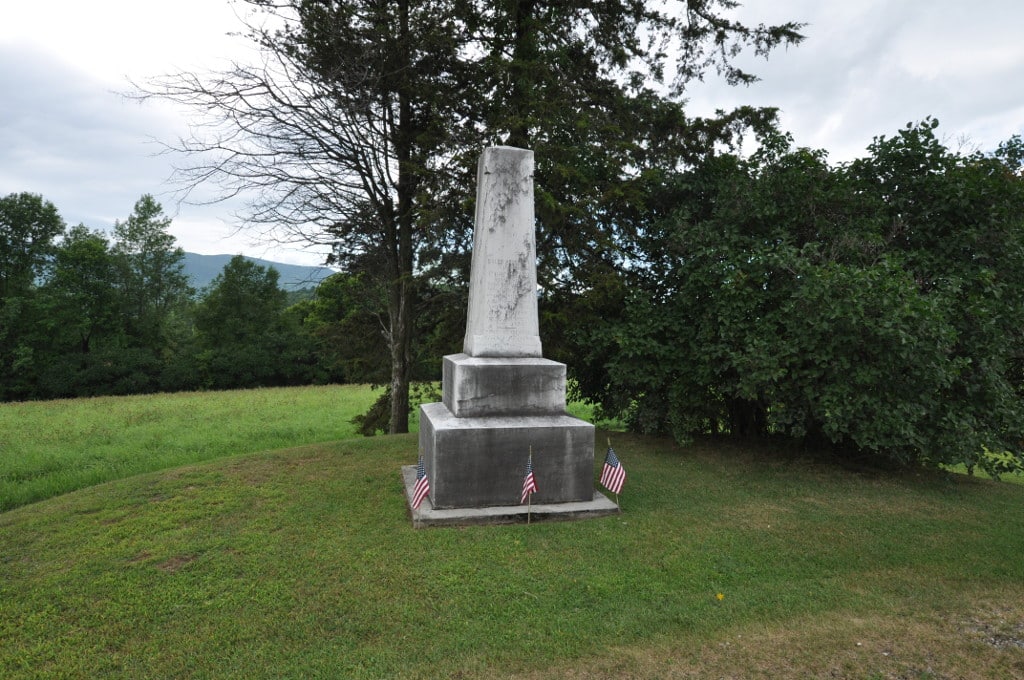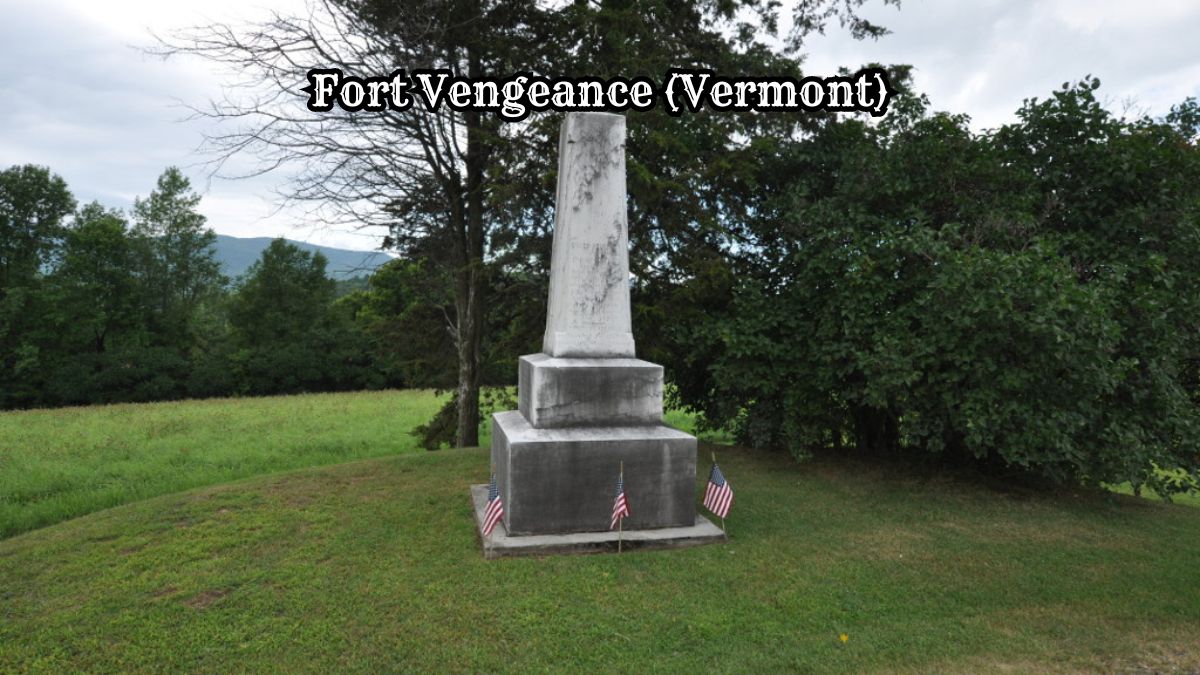Located in Pittsford, Vermont, Fort Vengeance stands as a symbol of American resilience during the Revolution.
Established in 1780, this fort was pivotal in defending American settlers from British and Native American attacks.
The Vermont Historical Society has preserved its rich history, making it a significant site for history enthusiasts.
The Fort Vengeance Monument Site offers visitors a glimpse into the past.
Detailed information panels and preserved artifacts thoroughly understand this historic fortification.
These grounds offer an engaging and worthwhile visit for those drawn to military history or the American Revolution.
History of Fort Vengeance (Vermont)
Fort Vengeance played a significant role during the American Revolutionary War.
This section provides insights into its involvement in the war, notable figures associated with it, and its strategic importance during Burgoyne’s invasion of Vermont.
The Role in the American Revolutionary War
Constructed in 1777, Fort Vengeance served as a crucial defensive position for the American forces.
Its location in Vermont provided a strategic advantage for monitoring British movements and securing the frontier.
The fort housed a small garrison, repelling British and Native American raids.
It also served as a staging point for counter-attacks, aiding the larger war efforts.
Notable Figures: Caleb Houghton and Caleb Hendee
Caleb Houghton and Caleb Hendee are two prominent figures associated with Fort Vengeance.
Houghton, known for his leadership, commanded a company stationed at the fort. His tactical acumen was instrumental in defending the area.
Hendee, another critical figure, provided essential surveillance and communications.
Both men exemplified bravery, contributing significantly to the fort’s operations and the protection of Vermont.
Burgoyne’s Invasion and the Importance of Vermont
During General Burgoyne’s 1777 invasion, Vermont’s role became increasingly vital.
Fort Vengeance stood as a barrier against the British advance. The fort’s garrison disrupted supply lines and harassed enemy troops, slowing down Burgoyne’s progress.
This delay contributed to Burgoyne’s eventual defeat at the Battle of Saratoga, which marked a turning point in the war.
Fort Vengeance Today

Fort Vengeance is highly significant today because of its inclusion in the National Register of Historic Places, the presence of the Fort Vengeance Monument Site, and the efforts of local organizations in recognition and education.
National Register of Historic Places
Fort Vengeance is listed in the National Register of Historic Places.
This designation helps protect and preserve the site, recognizing its historical importance.
It also opens opportunities for grants and funding to maintain the area.
The Vermont Historical Society plays a role in supporting activities related to the fort.
Visitors can find this information on Local 22 and Local 44 news channels, which sometimes feature segments on the fort.
Fort Vengeance Monument Site
The Fort Vengeance Monument Site is a key location for those interested in the fort’s history.
The monument is a tribute to the fort’s historical relevance and is located near the original site.
Maintained by the Pittsford Historical Society, the site includes informational plaques.
Visitors can explore the grounds and learn about the fort’s role locally.
Local Recognition and Education
Local organizations, including the Pittsford Historical Society and Vermont Historical Society, actively work to educate the public about Fort Vengeance.
Educational programs, tours, and events highlight the fort’s history and regional impact.
Local 22 and 44 and “This Place in History” offer media coverage about the fort.
Schools and community groups often visit the site to discuss Vermont’s colonial history.
Explore More: 10 Historic Forts in Vermont: An Amazing Historical State
Structural Details and Archaeological Findings
Fort Vengeance reveals important insights through its architectural design and the artifacts found.
The site includes a palisade fort, various artifacts now housed in a museum, and a stone memorial and a marker commemorating its historical significance.
Architectural Design of the Palisade Fort
The Palisade Fort at Fort Vengeance featured a wooden stockade, constructed from sharpened logs.
Each log was positioned vertically, creating a formidable barrier against potential attacks.
The fort also included lookout towers at each corner, providing a 360-degree field view.
The fort had essential structures such as barracks, storage buildings, and officer quarters.
These buildings were arranged deliberately to maximize space and functionality.
Evidence suggests the use of earthworks and trenches as additional defensive mechanisms. The overall layout was designed to withstand sieges and provide a secure base of operations.
Artifacts and Exhibits at the Museum
Artifacts from Fort Vengeance offer a glimpse into the daily life of its inhabitants.
Items such as musket balls, tools, and utensils have been unearthed and are displayed in the local museum.
Weaponry found at the site includes flintlock muskets, bayonets, and various edged weapons, highlighting the fort’s military focus.
Personal items such as buttons, buckles, and coins indicate the presence of soldiers and civilians.
Pottery shards and metal fragments suggest domestic activities, while trade items like beads showcase interactions with local Indigenous communities.
The museum organizes these artifacts into themed exhibits, providing context and enhancing the visitor experience.
Stone Memorial and Marker Overview
The stone memorial at Fort Vengeance is a tribute to the fort’s historical significance.
The monument, erected in the 19th century, details the fort’s history and its role in regional conflicts.
The nearby marker offers additional information, including the dates of key events and the names of known military leaders and personnel.
Visitors often find the memorial and marker to be poignant reminders of the struggles faced by those who once occupied Fort Vengeance.
Inscriptions on these structures provide concise yet informative summaries of the fort’s legacy. These commemorative elements educate the public and preserve the site’s historical narrative.
Cultural Significance
Fort Vengeance has played a notable role in American history, particularly during the Revolution. Its legacy is preserved through commemorative events and connections to other historical sites like Fort Ticonderoga.
Commemorative Site and Events
Fort Vengeance is preserved as a key historical landmark in Vermont.
Various commemorative events are held annually to honor its contributions during the American Revolution.
These events often include reenactments, educational programs, and guided tours that educate the public about the fort’s historical significance.
Local schools and communities participate actively in these commemorations, fostering a strong sense of local history.
Displays often include artifacts found at the site and informative plaques that provide context on the fort’s role in the 18th century.
Fort Ticonderoga and Its Relation to Fort Vengeance
Fort Ticonderoga, located near Lake Champlain, shares a historical connection with Fort Vengeance.
Both forts played vital roles during the American Revolution, although Fort Ticonderoga is more widely known.
The two forts were part of a network of military installations that helped secure the northeastern frontier.
Educational programs and historical analyses often compare the strategic importance of these forts.
While Fort Ticonderoga received more attention, Fort Vengeance’s contributions were equally critical in securing the region.
Tours and exhibits sometimes feature joint presentations about the fortifications around Lake Champlain.
Representations in Media and Literature
Fort Vengeance has been represented in various forms of media and literature over the years.
Books and documentaries often explore its role in the American Revolution, focusing on the fort’s strategic importance and daily life for its inhabitants.
These representations help preserve the memory of the fort and make its history accessible to a broader audience.
Historical novels, films, and television series sometimes feature Fort Vengeance.
They portray dramatized accounts of historical events, bringing the fort’s history to life engagingly.
Educational broadcasts and historical fiction writers frequently use the location to discuss broader themes of struggle and survival during the Revolutionary era.
Geography Surrounding Fort Vengeance
Fort Vengeance is strategically positioned along United States Route 7. Its proximity to historic homesteads enhances its historical significance, especially the role it played during the American Revolution.
Location on United States Route 7
Fort Vengeance is strategically situated along United States Route 7.
This major north-south highway runs through Pittsford, Vermont, providing easy access to numerous key locations.
Situated around seven miles north of Rutland, the fort has historically served as a critical hub in the transportation network.
Route 7 connects various communities along its path, facilitating trade and movement. This advantageous location has made it a focal point for historical study and tourism, offering a glimpse into the region’s past.
Proximity to Vermont’s Historic Homesteads
Fort Vengeance lies near some of Vermont’s oldest documented homesteads.
Its proximity to these historic sites amplifies its value, offering a deeper insight into early American life.
The nearby homesteads include structures dating back to the 18th century, vividly depicting the era.
Visitors to the area can explore these preserved sites, gaining a better appreciation for the daily lives of early settlers. This connection enriches the experience, providing context and history beyond just the fort itself.
Strategic Importance During the American Revolution
During the American Revolution, Fort Vengeance held significant strategic importance.
It served as a defensive structure, protecting settlers against attacks.
Its location was chosen to monitor and control movements along Route 7 and the surrounding areas.
The fort’s placement allowed for effective communication and coordination among American forces.
This pivotal role in regional defense underscored its value in the broader context of the war.
Military Engagements and Campaigns
The military engagements around Fort Vengeance involved strategic actions against British forces from Canada, local militias from Castleton and Royalton, and Ebenezer Allen’s notable contributions.
Actions Against British Forces from Canada
Fort Vengeance was a site of several skirmishes involving British forces advancing from Canada.
These battles primarily revolved around the control of strategic points in Vermont. Soldiers stationed at the fort often engaged British troops to prevent incursions.
Fort Warren also provided support. The confrontations were typically small-scale but crucial to maintaining territorial integrity.
Local Militias: Castleton and Royalton
Local militias from Castleton and Royalton were essential in defending against British-related threats and raids by Indian allies of the British.
These towns provided a steady flow of volunteers who augmented the fort’s defenses.
Militiamen conducted patrols and responded swiftly to incursions. Their intimate knowledge of the terrain gave them an advantage in guerrilla tactics.
Ebenezer Allen and His Role
Ebenezer Allen was a key figure in the fort’s military campaigns. His leadership and tactical acumen significantly contributed to the defense efforts.
He is credited with organizing raids and leading counter-attacks against British and Indian forces.
Allen’s ability to mobilize local forces and coordinate with Fort Warren underscored his role in the broader defensive strategy. His actions were instrumental in maintaining a defensive posture in a contested region.

Cory is a website owner and content creator who enjoys fishing, history, coin collecting, and sports, among other hobbies. He is a husband and father of four.
Romans 15:4 For whatever was written in former days was written for our instruction, that through endurance and through the encouragement of the Scriptures we might have hope.

